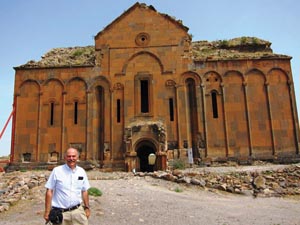Denise Altounian
Staff Writer

Photo: Harry Tavitian
The area that today comprises Eastern Turkey, holds both enduring and painful memories for Armenians. Many grew up listening to stories their grandparents and great-grandparents told about their lives in places such as Erzerum, Van, Kharpert and many other Armenian inhabited cities and towns within the Ottoman Empire. Unfortunately, the Genocide of 1915 brought a sudden and tragic end to Armenian life in these communities, and others like it. Constantinople too, had once been home to a strong and thriving Armenian community of intellectuals, businessmen, and artists, but is now much reduced in population.
While some have made the pilgrimage to historic Armenia others are left wondering what that area holds today. Professor Barlow Der Mugrdechian, Coordinator of the Armenian Studies Program, was able to answer many of those questions in his presentation “Historic Armenia: Memories and Images,” detailing his trip last summer to Turkey, to see the remnants of what was once historic Armenia. The lecture, which was sponsored by the Armenian Studies Program, took place on Wednesday, November 14, in the University Business Center.
Professor Der Mugrdechian’s trip took place between June 23 and June 29. He traveled from Yerevan to Kars, Ani, Van, Bitlis, Moush, and Erzerum, and visited many other sites on the journey. Among the highlights of the trip was a visit to the Monastery of Varak and the island of Akhtamar in the region of Van. In the region of Moush, the greatest impact he felt was made by a visit to the St. Karapet Monastery and the Arakelots Monastery, both in Moush, and both of which had played important roles as being among the oldest pilgrimage sites in Armenia.
The lecture outlined many of the changes that have taken place since 1915 and the state of the region today. The Armenian presence could still be seen and felt throughout the lecture. Many of the sites that were home to Armenians families now show little signs of what was once there. Many of the churches have since been destroyed either by intentional action of the government or earthquakes. It is interesting to note that many of the areas once inhabited by Armenians are now home to Kurds.
During a week spent in Istanbul in mid-June, Professor Der Mugrdechian visited the Armenian Patriarchate and met with Archbishop Aram Ateshian, visited Armenian churches and schools, walked the grounds of the Shishli Armenian cemetery, and visited the offices of the Agos newspaper, which was particularly moving as the editor Hrant Dink was assassinated in 2007 for speaking out about the Armenian Genocide.
The audience left with a clearer idea of what life is like for Armenians in present-day Turkey and what has happened to many of the Armenian churches and historical monuments.
“It was very interesting, yet sad to see so much Armenian history. It was also disheartening to find out that the Turkish government tries to make it look like the Armenians committed atrocities against them,” said senior Arpy Soghomonian.
For those in the audience, it was painful to see the images of so many damaged or destroyed churches, all that endures of a once thriving Armenian culture. Despite the pain, it was something that every Armenian should see, as part of our history. The Armenian spirit will always be felt in Turkey, even if it can no longer be easily seen.
 Hye Sharzhoom Armenian Action
Hye Sharzhoom Armenian Action